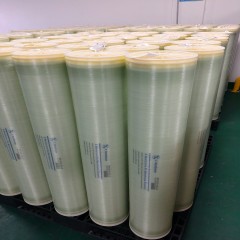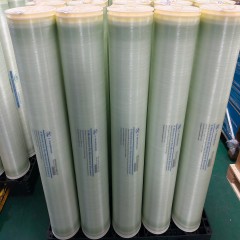Reverse Osmosis Membrane Technology: Principles, Applications, and Key Insights
November 22, 2024
RO membranes operate through a pressure-driven process where water is pushed through a semi-permeable membrane, leaving impurities behind.


- Separation Mechanism: The membrane selectively allows water molecules to pass while rejecting salts, minerals, and other contaminants.
Purity Level: RO technology can achieve up to 99.5% salt rejection, ensuring water meets high-purity standards for various applications.
2. How Reverse Osmosis Membranes Are Made
RO membranes are typically made using polyamide (PA) thin-film composite (TFC) materials. The layered structure includes:
- Polyamide Active Layer: Provides high rejection rates for salts and organics.
- Porous Support Layer: Enhances mechanical strength while allowing water to flow freely.
- Non-Woven Fabric Base: Adds structural stability.
Key manufacturing technologies include:
- Interfacial Polymerization: Creates ultra-thin, defect-free active layers for optimal performance.
- Surface Modifications: Enhance anti-fouling properties and chemical resistance.
RO membranes are widely used across various sectors:
Seawater Desalination
RO membranes transform seawater into freshwater, providing critical support in regions like the Middle East, Africa, and South America where water scarcity is severe.
- Energy-Efficient Designs: Modern RO membranes significantly reduce energy consumption in desalination ro plants.
Industrial Applications
- Power Plants: Produce ultra-pure water for boiler feed.
- Textile Industry: Treats high-salinity effluent, promoting wastewater recycling.
- Pharmaceuticals: Ensures stringent purity standards for water used in drug manufacturing.
Household Water Purification
RO membranes are essential in water purifiers, effectively removing heavy metals, pesticides, and dissolved solids for safe drinking water.
4. Advancements in RO Membrane Technology
While RO membranes have revolutionized water treatment, ongoing innovations address key challenges like fouling and energy consumption:
- Low-Energy RO Membranes: Operate effectively under lower pressures, reducing operational costs.
- Anti-Fouling Coatings: Minimize biofouling and scaling, enhancing membrane lifespan.
- High-Pressure RO Membranes: Withstand extreme operating conditions, ideal for industrial use.
- Nanotechnology Integration: Improves rejection rates and boosts membrane permeability.
5. Why Choose High-Performance RO Membranes?
High-performance RO membranes stand out due to their superior efficiency and durability:
- Reliable Performance: Achieve a guaranteed salt rejection rate of 99.5%.
- Longevity: Backed by a 3-year warranty, ensuring long-term reliability.
- Cost-Effectiveness: Reduced maintenance and energy consumption lower total ownership costs.
- Versatility: Suitable for a wide range of applications, from seawater desalination to industrial and domestic water treatment.
If you're looking for advanced reverse osmosis membrane solutions, our team is here to help. Contact us for tailored recommendations!





 Language
Language





 Network Supported
Network Supported